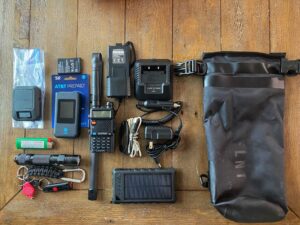 So, business travel seems to be a thing again. I’m not thrilled about it. After staying home for two years, and spending it with my nuclear family, I really don’t want to get back on a plane to travel for business. I’d rather work from home, do my job, and not travel again for work, unless my wife and kiddo can come with me. You know, a family vacation, if they exist any longer.
So, business travel seems to be a thing again. I’m not thrilled about it. After staying home for two years, and spending it with my nuclear family, I really don’t want to get back on a plane to travel for business. I’d rather work from home, do my job, and not travel again for work, unless my wife and kiddo can come with me. You know, a family vacation, if they exist any longer.
That said, I don’t think it’s any secret, with (in my humble opinion) potential threats such as EMPs (think Chinese Balloons), nuclear war , cyber attacks , all of which are global threats, that anyone that is forward thinking getting on a plane to travel for work, has to be thinking about the potential for disaster that could quite frankly happen anytime. Call me pessimistic, but as someone who feels like they are more than a casual observer of the $#!& that is going on around us, I feel the need to up my game a little when I travel, no matter where I travel. It could be in the car, or by plane. The plan is ALWAYS to get home to my family in the shortest time possible.
So before I traveled to the west coast this last month for work, I decided I needed some new kit in order to feel more comfortable while traveling. The question I had was, “will TSA think I am a whack job, if they stop this gear from going through security and decide to search it out of curiosity.”
Admittedly, the gear is essentially centered around communications, being waterproofed/repellant, provide for power to the devices, give me the ability to communicate if the grid goes down for any reason. Now, based on that, if the grid goes down because of an EMP , it is clearly more severe (from a geography perspective) than a temporary grid outage. Don’t get me wrong, if electrical substations are sabotaged, expect at least 18 — 24 months without power before a repair (a SLOW REPAIR) to a substation is made. Even then, it is assumed whatever government faction is in charge will get their core geopolitical center up and running first, and then make plans to light up the rest of the country… Or not… It remains to be seen.
The Gear
Now to the point. In my effort to build a new travel EDC kit for personal and business travel, I took a couple of things into consideration. Communication with my family, and communication with our MAG. Very simple. Then I had to look at modes of communication. Satellite, Radio, and Cellular. Each one has its own platform, and in each case. Additionally, I realized, I would require power, which has its own drawbacks, electronic library, and lighting.
With that, I needed a vessel to carry this gear in that was compact, so it would fit in a backpack, and potentially not cause a stir at the airport. It just so happened that in one of my Battlbox shipments, I had received a SLNT 2.5 liter faraday dry bag . I’d been looking for a reason to add it to a kit, and this was the perfect solution and application for it. When I received it, I think like any discerning 54 year old prepper going on 9 years of age, I took it right out of the package, throw my cell phone in it, ran over to my wife, and said, “Hey call my cell phone,” to test out the bag. Guess what? Worked perfectly. No ring, no sound, nada. The faraday bag worked great. Blocked the mobile signal perfectly.
So what’s in the kit you ask? Here we go, and I’ll try to articulate as I go so that you know why I chose each piece of kit. My feeling’s won’t be hurt if you comment below and tell me I am crazy, or one piece of kit is crap for one reason or another. We all choose our gear based on our experience with it, or lack thereof for that matter depending on the situation.
So from left to right, in the top row of the image:
- Garmin InReach Emergency Satellite Communicator
- AT&T Flip phone with $50 Cellular Card and fully charged battery.
- Baofeng 8 Watt UHF/VHF handheld radio , with extended flexible antenna (fully charged battery)
- Baofeng extended life spare battery
- Baofeng charging equipment that comes with the kit when you buy it.
From left to right in the bottom row:
- Bic lighter (I always, no matter what have more than one lighter on me)
- USB Electronic Library
- Red keychain thumb ligh t
- Atactical WOWTAC 550 lumen tactical flashlight (Discontinued, but well used, and tested)
- POD Fusion 8000mah Solar Charger/Power Bank
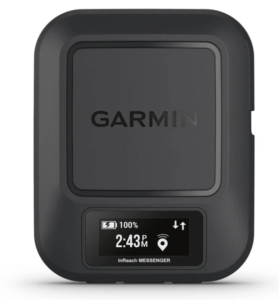 The Garmin inReach Satellite Emergency Communicator
The Garmin inReach Satellite Emergency Communicator
I will be the first to admit, this was a very generous gift from a very close friend and MAG member. He gifted one to each of the guys in the group so that we could always have a way to stay in tough if traditional comms went down. While it is a subscription based service much like your mobile phone, it is well worth the nominal fee for the low end package to have peace of mind when traveling, if all else fails. A couple of really cool things you can do with it are:
- Two-Way Messaging: The device allows for two-way text messaging with individuals or groups anywhere in the world, even in areas without cellular coverage. This is useful for staying in touch with loved ones, getting updates on weather conditions, and sending SOS messages in case of an emergency.
- GPS Tracking: The inReach Messenger has a built-in GPS receiver that allows users to track and share their location in real-time. This can be helpful for coordinating with friends or family, and for emergency responders to find you quickly in case of an emergency. One of the coolest features, at least in my opinion, is that it allows you to set up your own private URL that you can share with your MAG and family so that in an emergency they could track you. Or you can provide them with the URL in the event you decide to simply go hiking so everyone can follow your trail from a phone or laptop computer.
- Weather Forecasts: The device can provide weather updates for the user’s location, as well as for planned routes. This feature can help users make informed decisions about their activities and avoid dangerous weather conditions.
- Navigation: The device has a built-in compass and the ability to download maps, making it easier to navigate in remote locations. It can also provide turn-by-turn directions to specific locations.
- Battery Life: The inReach Messenger has a long battery life, allowing users to stay connected for extended periods of time. Additionally, the device can be charged through a USB port or solar panel .
Like I mentioned earlier it does come with a monthly subscription fee. It starts at $15.95 a month, and IMHO, well worth it.
This little unit would allow me to communicate in the event of a grid down scenario whether an EMP, or a mass power outage due to substation failure. It would also allow those who care about me to track my whereabouts, “assuming” there was still Internet access, even for a short period after a grid down situation.
The downside is that texting from the unit is a bit cumbersome. There’s a process, and it’s not difficult, just cumbersome.
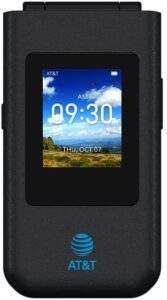 AT&T Prepaid Flip Phone
AT&T Prepaid Flip Phone
This one is pretty self explanatory. It is essentially a burner phone . Taking that into consideration this is simply a replacement for my existing iPhone in the event it is lost or destroyed.
I chose this design, form factor, and the fact that it is prepaid for a couple of reasons.
- Affordability: This was ridiculously affordable. I think I paid $30 or something like that.
- It has a compact and durable design. This legacy flip phone is small and lightweight, making it easy to carry around. It has a durable design that can withstand rough handling and accidental drops, which can be important in an emergency situation.
- I can buy a number of prepaid cards to keep with it without spending a fortune, and can add them whenever I like. You get Voice, Text, and some Internet minutes.
- Remember when the battery life of your phone would last a week or more? You get the same battery life with this type of phone you remember when you had one of these types of phones in your pocket.
- It has a simple and intuitive user interface that makes it easy to use. You’ll remember how to use it.
Because it is basic and doesn’t have a plethora of mobile apps like my iphone, I can likely depend on not being distracted by them or potentially waste a ton of time, using it only for the communications I need while on the road to home.
Baofeng UV-5R 8‑Watt Handheld Radio
The Baofeng UV-5R is a sweet little handheld 2‑way radio that’ll make your emergency preparedness game stronger. It’s a five (5) or eight (8) watt dual-band radio that has long-range communication abilities, depending on how you use it. You can potentially talk to anyone, anywhere with this thing! Plus, it’s got a super cool feature where it can operate on both VHF and UHF frequencies, so you’ll never miss a beat. It used to only come in 5 watt transmission capacity, but recently (and I think, I could be wrong) they upgraded the unit to 8 watts when they went with a more digital vs. analog version of the unit…
The UV-5R is fully programmable too, so you can easily access the channels you need in case of an emergency. You can program FRS, as well and use it as an all around consumer walkie talkie if you like. You won’t need to mess around with it during a crisis, which is a huge plus, once it’s programmed as you can choose either a preset channel mode or a frequency mode to manually change your frequencies. And the best part? It’s compact and portable, so you can easily stash it in your backpack, bug-out bag, or even on your belt. In my case, the SLNT faraday bag.
Our MAG has our Baofeng pre-programmed with a number of channels on various frequencies, including NOAA weather, cause, well, you never know when you’re going to need the weather, and we do live near the ocean. We’ve tested them on numerous occasions. We’ve tested them in the field on FRS as well, and line of sight can get a bit over a mile of reception. I will admit, on one occasion we got a 5 mile communication out of them. From a HAM radio perspective, however, taking into account mathematics, weather, cloud cover, etc, you can speak to someone clear across the ocean or the country…
If you’re looking for something with emergency features, the UV-5R has got you covered. It comes with a built-in flashlight and an emergency alarm, so you can let people know you need help in a jiffy. And if things get really dire, there’s even an SOS function that’ll send out a distress signal.
All in all, the Baofeng UV-5R is a nifty little radio that’s perfect for those who want to be prepared for anything. Whether you’re camping in the great outdoors or just want to have a reliable means of communication in case of an emergency, the UV-5R is a great choice. Just make sure your MAG, family members, etc. know how to use them, and when to use them.
Baofeng Extended Battery Life
Additionally, I also have the 3,800mah extended life battery . If you have used a UV-5R and let it sit for a year without turning it on, you’ll know these batteries are amazing and dissipate their charge very, very, very slowly. I have several that are rarely turned on, and I can attest the battery life on them while in storage is absolutely amazing.
The additional charging equipment is actually the rest of the charging equipment that comes with the Baofeng in the box when you buy it. They are ridiculously inexpensive and an invaluable tool for preppers and preparedness, as well as being versatile for fun or serious use.
USB Library
This is simply a USB key that has a library of documents on it that I may want or need to utilize if I need to or have access to it. I do carry good old fashioned paper pamphlets like manuals with me whenI travel. I am a firm believer that under duress, everyone needs to have some guidance no matter how seasoned they are, and a few little thin, foldable manuals on first aid, or gear improvisation could be a huge help. However, there are some critical books on the USB key I keep with me.
This is something you can put together yourself based on your own skill set, your geography, etc. But more on that another time for another post… And before you ask, yes, I would normally have a tablet or laptop with me.
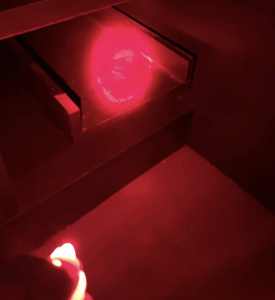 Mini Keychain Light with Red Bulb
Mini Keychain Light with Red Bulb
I cannot take credit for this. But for the $8.00 bucks, a pack of six of these mini keychain flashlights are fantastic. Why, because at night if you are out and about and you need light for a map, or to see something, this won’t kill your night vision. The lumen count is small at 12 lumens, is just bright enough even in low light and definitely bright enough in no light.. It is small, but these things take up no space, have no weight. I would recommend several of them. Keep them in your backpack, bug out bags, car, keys, and make it part of your EDC. I have used it on more than one occasion and chuckled at myself that I even had it on me. I have them all over my travel gear for work, on zippers of jackets, etc.
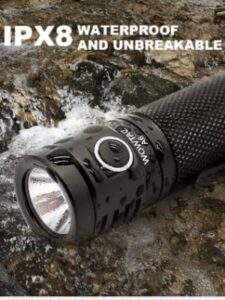 Atactical WOWTAC 500 Lumen Flashlight
Atactical WOWTAC 500 Lumen Flashlight
It should be noted that this flashlight was discontinued, and I have had it for a couple of years. I didn’t beat on it, I didn’t run over it with my truck, and I didn’t chop it out of a block of ice. But it’s stood up to being dropped, accidentally kicked, rolled around on the ground, had stuff spilled on it, etc. And it has been replaced by other models, most notably the WOWTAC 1460 Lumen flashlight .
The WOWTAC 1460
I have had the opportunity to test out the WOWTAC 1460 lumen tactical flashlight , and I must say, I am impressed with its performance and features.
Firstly, the flashlight is pocket-sized, and is lighter and smaller than it’s 500 lumen predecessor, making it extremely convenient to carry around with you wherever you go. It’s lightweight and easy to grip, ensuring that it won’t slip out of your hand even when you’re on the move.
The brightness of the WOWTAC flashlight is outstanding, with an impressive 1,460 lumens of power. This means that you can easily light up a room or a dark outdoor area without any trouble.
Another great feature of this flashlight is its rechargeable battery. You can easily charge it using a USB cable, and it will last for hours on a single charge. This is not only convenient, but it also saves you money in the long run, as you won’t have to constantly replace batteries.
In terms of durability, the WOWTAC flashlight is built to last, in my opinion. It’s made with high-quality materials that are designed to withstand extreme conditions, and it’s also waterproof, so you can use it in the rain without any worries.
And… If you’re price sensitive, it’s not an $80 or $149 flashlight. It’s $30… Now if you’re a flashlight snob, you’ll turn your nose up at this. If you’re thinking about the money in your pocket, and inflation, $30 isn’t so bad.
Overall, I would highly recommend the WOWTAC 1460 lumen tactical flashlight to anyone looking for a reliable, high-performance flashlight. It’s perfect for a range of uses, from outdoor adventures to everyday use around the house.
 Portable POD 8000mah Solar Recharger
Portable POD 8000mah Solar Recharger
So, I recently got my hands on the POD Fusion solar power bank. Transparently, I got it off of Battlbox.com , but there are MANY other ones out there . Here’s what I think about it.
First things first, the power bank is definitely about the size and form factor of a cell phone, so it might not be the most portable option out there. There are bigger, there are smaller. But this one seems to have an adequate weight, and fits in the faraday bag . It has 8,000mAh battery capacity, which means that you can charge your phone a couple of times before needing to recharge the power bank itself, by plugging it in or by sunlight. I know, there are battery packs out there with 10,000mAh capacity. This one is light though, and that was a consideration.
One of the main selling points of this power bank is the fact that it has a solar panel built-in, which means that you can charge it using solar power if you’re out and about. While it’s a nice feature to have, it does take a while to charge the power bank using solar power alone, so it’s not the most efficient method. That being said, it’s a great backup option to have if you’re in a pinch.
The power bank also has two USB ports, so you can charge two devices at the same time, which is really convenient. It also has a flashlight built-in, which can come in handy if you’re in a dark environment. Not to mention the opposite side of this has a 20 LED lamp that is plenty bright.
The build quality of the power bank seems to be pretty solid, with a durable and rugged design that should be able to withstand some wear and tear, even though it is going to sit in the faraday bag 95% of the time. It’s also water-resistant, which is always a plus.
One thing to keep in mind is that the power bank does take a while to fully charge, so you’ll need to plan ahead if you want to use it for an extended period of time.
Overall, the POD Fusion solar power bank is a solid option for those who need a high-capacity power bank that can handle some rough use. While the solar charging feature isn’t the most efficient, it’s still a nice backup option to have, and the two USB ports and built-in flashlight are definitely useful features.
And that’s it. This is my travel communications kit for business and personal use. The kit stays in my truck when not traveling for work, and goes in my backpack when I get on a plane. The question about whether or not it gets through TSA security without being torn apart in a search, well, it does. Thus far, it’s not been requisitioned for a search after being X‑rayed.
Let Us Know What You Think
Let me know if you have any questions. Feel free to register, and comment with your thoughts. Would you carry a kit like this? Do you carry a kit like this?




In reply to Tony .
So, keep in mind, and I likely should have put this in the blog post… That it does not necessarily necessitate a CME or EMP only. If there is an attack on the grid, Sat & Mobile service will work, with mobile service being the first to go down due to the batteries pushing data via the 3G, 4G, and 5G antenna(s)…
It is also not lost on me that China has plans to cyber attack satellites and take them out too. The gear is to hedge bets. Nothing is foolproof…
how many of these items and their support systems are EPM / CME proof?